

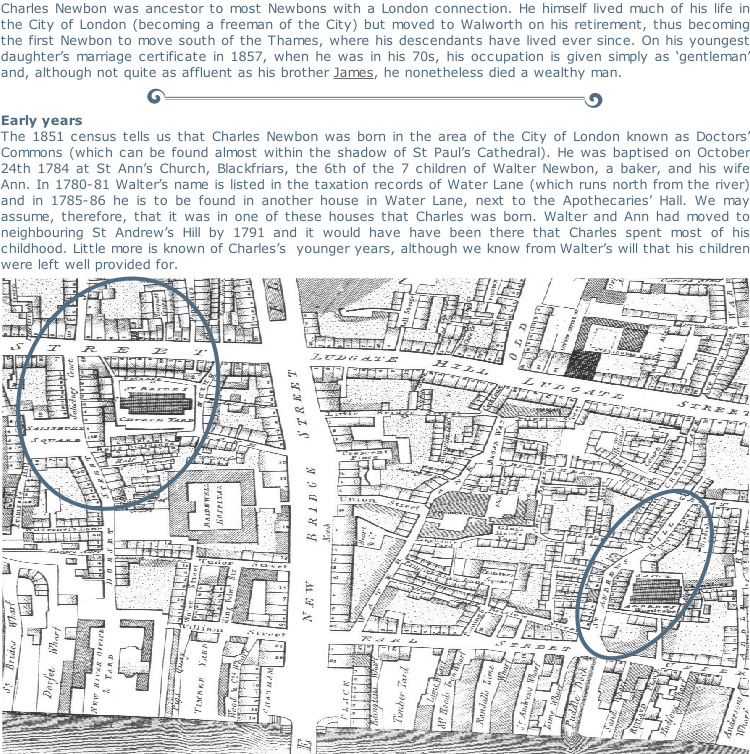
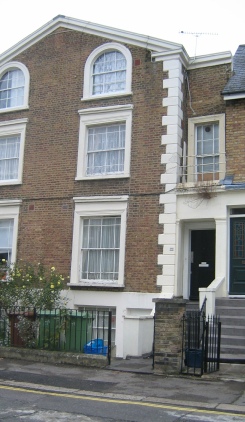
Charles and Henrietta’s 4 eldest children were born at a house in St Bride’s Passage (immediately next to the church) and the younger children were born on the other side of Fleet Street at 5 Racquet Court. It would seem that Charles and Henrietta moved to Racquet Court between 1817 and 1820 and they stayed there until the mid-
Professional life
Charles Newbon, like his father Walter, must have had a good head for business. He appears in the City trade directories throughout the 1820s, 1830s and early 1840s as a tailor and draper and he is referred to in several sources as a ‘tailor master’ – in the records of the Bakers’ Company of the 1820s, for example, he can be found as a master taking on boy apprentices. In the Post Office directory of 1841 he can be found trading under the name Charles Newbon and Son – this latter was most likely his second son, Walter Henry, who was still a bachelor and (as the 1841 census reveals) living at home with his parents and sisters. John, the elder son, already had a family by this stage and can be traced to various addresses at this time.
where Charles and Henrietta Newbon died
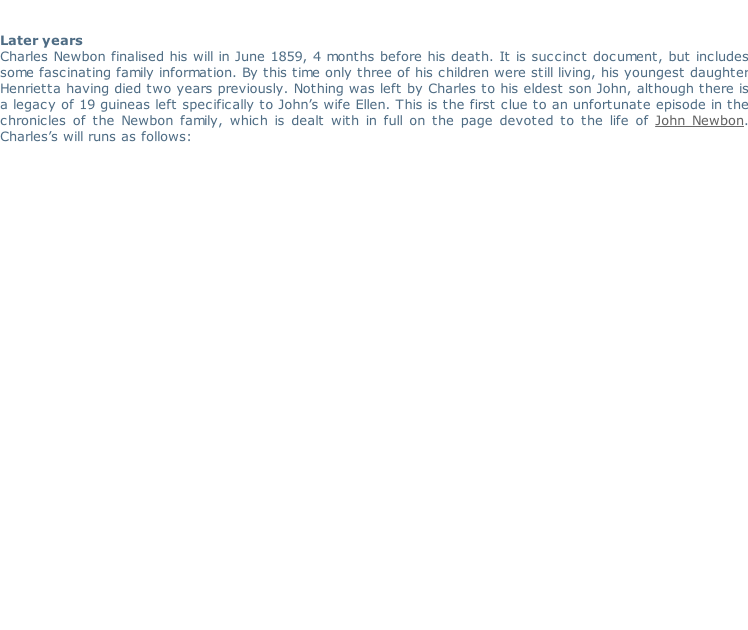
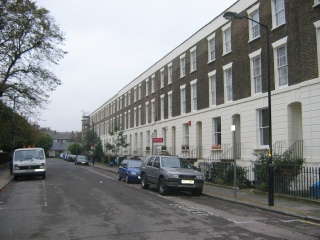
Henry Newbon lived in the 1850s?
|
|
Charles Wood Huntley, Charles and Henrietta’s eldest son, was clearly a favourite grandchild of Ann Newbon, for a number of legacies were bequeathed to him and his cousin Sarah Jane Newbon in Ann’s will drawn up in 1822. Charles’s early death must have been a bitter blow, and John Newbon thereafter would have felt a new importance within the family, with Charles’s legacies passed to him. The origins of Charles Wood Huntley’s middle names are unknown.
|
|
|
John Newbon was the ancestor of a many London Newbons. His life should have been one of prosperity but it unfortunately took a different course, outlined on the page devoted to his story.
|
|
|
Charles Newbon’s two daughters both married but both died young. Diana Nancy Newbon married John Edward
|
|
Born: |
1784 (Blackfriars) |
Died: |
October 5th 1859 (Newington) |
|
Father: |
Walter Newbon (1750- |
Mother: |
Ann Newbon, formerly Dixon (c.1743- |
|
Spouse: |
Henrietta Harriet Blyde (c.1790- |
Occupation: |
Tailor |
|
Children: |
Charles Wood Huntly Newbon (1811- James Newbon (1817- Diana Nancy Newbon (1824- Henrietta Newbon (1833- |
||
This is the Last Will and Testament of me Charles Newbon of Grosvenor Park Camberwell in the county of Surrey Gentleman I direct the payment of my just debts funeral and testamentary expenses I bequeath the legacy of nineteen guineas to the wife of my son John Newbon I give and bequeath all my estate and effects whatsoever and wheresoever unto my executors hereinafter named their executors administrators and assigns upon trust to make sale thereof and convert the same into money and to invest the proceeds of such sale in government securities or upon improved and sufficient mortgages or to permit the same to remain in its present state of investment and upon trust to pay the interest dividends and annual produce of such my estate unto my wife Henrietta for her separate and inalienable use during her natural life and after her decease upon trust to divide the same equally between my son Walter Henry Newbon and my daughter Diana the wife of John Murray for her separate and independent use free from the debts and control of her husband and I appoint my said wife and my son Walter Henry Newbon and my son in law the said John Murray Executors and Trustees of this my will and I direct that their receipt shall be a sufficient discharge for any purchaser or purchasers of any portion of my estate as witness my hand this sixth day of June in the year of our Lord one thousand eight hundred and fifty nine — Chas. Newbon — signed and acknowledged by the said Charles Newbon as and for his last will in the presence of us who at his request and in his presence and in the presence of each other have hereunto subscribed our names as witnesses this sixth day of June one thousand eight hundred and fifty nine — Thomas Newbon — Frederick Heritage Solicitors 1 Wardrobe Place Doctors Commons
Proved at London 7th Nov.r 1859 by the oaths of Walter Henry Newbon the son and John Murray two of the Executors to whom admon was granted power reserved of making the life grant to Henrietta Newbon widow the relict the other executor when she shall apply for the same.
|
|
Murray, a baker in the City of London, in 1853 but died childless in 1861 at the age of 36. Henrietta Newbon married William Turner, a bank clerk from Camberwell, in 1857, but died from an epileptic fit within only a few months of the wedding; she was aged only 24. One can imagine the grief her parents must have felt at losing a 6th child.
|
|
|
Put simply, Florence Ellen Newbon was unlucky in love. In 1880 she married Craven Bourne, then a glass painter, and the following year a son, Craven Ingledew Bourne, was born to the couple. But within a few years the marriage was clearly in difficulties and Florence became the only known member of the Newbon family at this time to be divorced. Since divorce would have been a rather extreme and certainly expensive option, the couple (or at least the husband) must have felt very strongly that this was the only viable option. Particularly unexpected, however, is that Craven Bourne filed for divorce twice over, first (unsuccessfully) citing as grounds Ellen’s relationship with a Mr Davenport in the 1880s and secondly in 1895 with Carl Emil Spreng, a German gentleman. On this second occasion the divorce was granted, although sadly Carl died later that year before the decree absolute took effect in 1896. The National probate records of 1933 give the death of ‘Florence Ellen Bourne or Spreng’ as having taken place on November 22 the previous year at the Hotel Cliveden at Westcliff-
|
|
|
Constance married John Henry Holford at Hammersmith in 1897 and had one daughter.
|
|
|
Ethel married Charles Stubbs, a solicitor’s clerk, at Brixton in 1887. The 1911 census confirms that Ethel and Charles had no children.
|
|
|
Walter, who, like his father, grandfather and uncle before him, became a tailor, moved to Portsmouth, where he died in 1910, having married Rose Charlotte White at Southsea in 1893; the couple had two daughters. After Walter’s death Rose married John Setford in 1922 and died at Portsmouth in 1951.
|
|
|
Samuel Martin Newbon married twice: his first wife Catherine (Kate) Saunderson, whom he married at Middlesborough in 1889, was committed to the County Lunatic Asylum at Sedgefield and died of septicaemia following an operation at the age of only 28; he married secondly Ellen Stemp in Brighton in 1901, when he was listed as a commercial clerk. Samuel died of tuberculosis in 1913 at Chelsea at the age of only 47. The 1911 census show that Samuel and Ellen had three children.
|
|
|
Grace Lillie Newbon married Charles Bradbury at Islington in 1894; the couple had one child, Ernest C. Bradbury. After Charles’s death Grace married Robert Walter Smith, with whom she had three further sons, settling in the USA in Gloversville, near New York.
|
|
|
Ebenezer Octavius Newbon became an advertising agent and lived at 17 Hewitt Avenue, Wood Green, London with his wife Emma Louise, née Norman (whom he married at Southwark in 1900), and their two sons. Ebenezer died in 1938.
|
|
|
Alice Maude Marian married Heinrich August Luyken, who was born in Germany. Heinrich was evidently a gifted linguist and a keen writer. Indeed, he became one of the most respected authors in the artificial language Esperanto of his generation. Various articles can be found about him on the Internet and his books can also still be found for sale.
|
St Bride’s, Fleet Street, in whose church he married and where his children were baptised, lies to the left, across New Bridge Street.
Family life
Charles Newbon married Henrietta Blyde of Southwark on June 26th 1810 (when he was 25 or possibly just 26) in St Bride’s Church, Fleet Street, and it was in this parish that the couple lived for most of their married lives. Just 4 of their 9 children lived to adulthood, 2 sons (John and Walter Henry) and 2 daughters (Diana Nancy and Henrietta).
The parish records of St Bride’s are, for their time, particularly informative and give the causes of death of 3 of Charles’s 5 children who died young. Two of these children died in 1825: James, the 4th child (who was born only 3 weeks after the burial of his elder sister Henrietta Suzannah in 1817), died of ‘water on the brain’ at the age of 7 and was buried on January 19th 1825, and Charles Wood Huntley Newbon (the eldest child) died of ‘dropsy’ (now also known as ‘oedema’), aged 14, and was buried on May 15th; the youngest son William became the 2nd of the children to succumb to ‘water on the brain’, dying at the age of 9 months in 1832.
|
1841 |
- |
at home at 94 Dorset Street, St Bride’s, City of London with his wife Henrietta (listed as Mary!) and children Walter, Henrietta and Diana (listed as Dinah), and also one domestic servant. |
|
1851 |
- |
at home at 37 Grosvenor Park North, Newington with Henrietta and their children Walter, Henrietta and Diana (all listed as ‘assist in business’). This comment suggests that Charles was in fact still working at this time, although whether still in the City of London or locally in Newington is not known. |
Thomas Newbon, the solicitor who drew up Charles’s will, was his great-
Charles and Henrietta Newbon both died at their home in Walworth, in 1859 and 1860 respectively. Charles’s death was reported in The Times of Tuesday 11th October 1859, as follows:
Henrietta’s death was reported the following year on Friday March 9th 1860:
Charles Newbon on the census
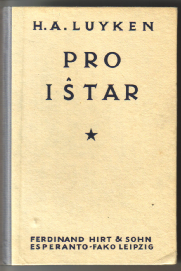
To Top of Page
| Site Map |
| Background to my research |
| Background to the surname NEWBON |
| Documents available and sources used |
| Name index |
| Walter Newbon's descendants |
| Northamptonshire Newbons |
| Redbourn, Hertfordshire |
| James Shelton Newbon |
| Henry Newbon |
| The Crickmer family |
| The Newbon Family and the City of London |
| Charles Evans Newbon |
| Joseph Newbon |
| The Brockelbank Family |
| The United Wards' Club of the City of London |
| John Newbon |
| The Children of John Newbon |
| World War I |
| Walter Thomas Newbon |
| The Newbon Family of Northamptonshire |
| Northamptonshire, the early home of the Newbon Family |
| King's Cliffe |
| Records of King's Cliffe |
| Maps of King's Cliffe |
| Links with elsewhere |
| News 2014 |
| News 2013 |
| News 2012 |
| News 2011 |
| News 2010 |
| News 2009 |
| News 2008 |
| Updates |
| To do |
| Guestbook |